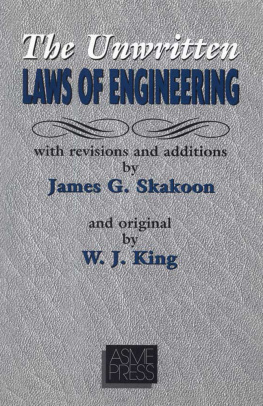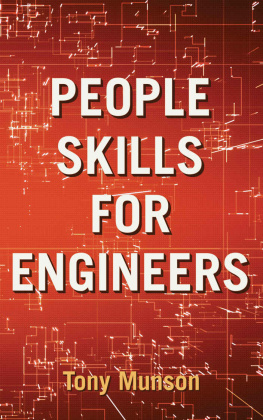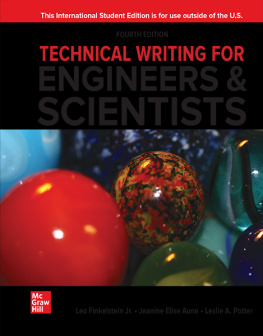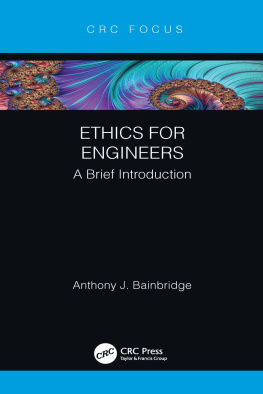
Statement from By-Laws: The Society shall not be responsible for statements or opinions advanced in papers...or printed in its publications (7.1.3)
INFORMATION CONTAINED IN THIS WORK HAS BEEN OBTAINED BY THE AMERICAN SOCIETY OF MECHANICAL ENGINEERS FROM SOURCES BELIEVED TO BE RELIABLE. HOWEVER, NEITHER ASME NOR ITS AUTHORS OR EDITORS GUARANTEE THE ACCURACY OR COMPLETENESS OF ANY INFORMATION PUBLISHED IN THIS WORK. NEITHER ASME NOR ITS AUTHORS AND EDITORS SHALL BE RESPONSIBLE FOR ANY ERRORS, OMISSIONS, OR DAMAGES ARISING OUT OF THE USE OF THIS INFORMATION. THE WORK IS PUBLISHED WITH THE UNDERSTANDING THAT ASME AND ITS AUTHORS AND EDITORS ARE SUPPLYING INFORMATION BUT ARE NOT ATTEMPTING TO RENDER ENGINEERING OR OTHER PROFESSIONAL SERVICES. IF SUCH ENGINEERING OR PROFESSIONAL SERVICES ARE REQUIRED, THE ASSISTANCE OF AN APPROPRIATE PROFESSIONAL SHOULD BE SOUGHT.
For authorization to photocopy material for internal or personal use under circumstances not falling within the fair use provisions of the Copyright Act, contact the Copyright Clearance Center (CCC), 222 Rosewood Drive, Danvers, MA 01923, Tel: 978-750-8400, www.copyright.com
Requests for special permission or bulk reproduction should be addressed to the ASME Technical Publishing Department.
ISBN No. 0-7918-0162-4
Reprinted with corrections, 2004.
Copyright 2001 by
THE AMERICAN SOCIETY OF MECHANICAL ENGINEERS
All Rights Reserved
Printed in U.S.A.
P REFACE
When my editor inquired about my interest in updating The Unwritten Laws of Engineering, I was delighted for the opportunity. The book had first been published as three articles in Mechanical Engineering in 1944, and was reprinted most recently in 1994, substantially unchanged from the original. When first reading it a few years ago, I was surprised at how well its advice had held up over the decades. Except for a few omissions and outdated laws, it seemed equally as fitting then as it must have been over fifty years before, and it was a lot of fun to read.
The biggest challenge was updating the book without ruining it altogether. Indeed, a common response from readers on what to change was: "Don't change anything. Why would you want to?" Well, some things just plain demanded it. At the same time, a new edition needed to retain timelessness; after all, the original survived more than half a century in fairly good health.
So, this updated edition keeps the style of the original and much of its content. Changes have to do with shifted societal values, changed employment laws, and evolved corporate structures. No apology is offered for the lack of reference to the latest technology (e-mail, computers, internet) this book's advice transcends the mere implements of the engineer. Some words and phrases in the original were painfully archaic and have been changed, but many of the old-fashioned words remain they add to the fun.
Although I wish to thank all those who helped with the text, Jennifer Kern, Dr. Steven Kern, and John Gillespie get special, personal thank-you's. Above all, I wish to acknowledge the original author, W. J. King. He mined and cut a little gem, and I am privileged to have been able to reset it.
James G. Skakoon
I NTRODUCTION
Prior to writing the first text of this book, the originating author admitted to having become very much aware, which can be observed in any engineering organization, that the chief obstacles to the success of individual engineers or of groups of engineers are of a personal and administrative rather than a technical nature. It was apparent that both he and his associates were getting into much more trouble by violating the undocumented laws of professional conduct than by committing technical sins against the well-documented laws of science. Since the former appeared to be unwritten at that time, "laws" were formulated and collected into a scrapbook as a professional code of sorts. Although they were, and in this latest edition still are fragmentary and incomplete, they are offered here for whatever they may be worth to younger engineers just starting their careers, and to older ones who know these things perfectly well but who all too often fail to apply them.
None of these laws is theoretical or imaginary, and however obvious they may appear, their repeated violation is responsible for much of the frustration and embarrassment to which engineers everywhere are liable. In fact, the first edition of this book was primarily a record derived from direct observation over 17 years of four engineering departments, three of them newly organized and struggling to establish themselves by trial-and-error. It has been supplemented, confirmed, and updated by the experience of others as gathered from numerous discussions, observations, and literature, so that it most emphatically does not reflect the unique experience or characteristics of any one organization.
Many of these laws are generalizations to which exceptions will occur in special circumstances. There is no thought of urging a servile adherence to rules and red tape, for there is no substitute for judgment; vigorous individual initiative is needed to cut through formalities in emergencies. But in many respects these laws are like the basic laws of society; they cannot be violated too often with impunity, notwithstanding striking exceptions in individual cases.
P ART I
W HAT THE B EGINNER
N EEDS TO L EARN
AT O NCE
IN RELATION TO THE WORK
However menial and trivial your early assignments may appear, give them your best efforts.
Many young engineers feel that the minor chores of a technical project are beneath their dignity and unworthy of their college training. They expect to prove their true worth in some major, vital enterprise. Actually, the spirit and effectiveness with which you tackle your first humble tasks will very likely be carefully watched and may affect your entire career.
Occasionally you may worry unduly about where your job is going to get you whether it is sufficiently strategic or significant. Of course these are pertinent considerations and you would do well to take some stock of them. But by and large, it is fundamentally true that if you take care of your present job well, the future will take care of itself. This is particularly so within large corporations, which constantly search for competent people to move into more responsible positions. Success depends so largely upon personality, native ability, and vigorous, intelligent prosecution of any job that it is no exaggeration to say that your ultimate chances are much better if you do a good job on some minor detail than if you do a mediocre job as a project leader. Furthermore, it is also true that if you do not first make a good showing on your present job you are not likely to be given the opportunity to try something else more to your liking.
Demonstrate the ability to get things done.
This is a quality that may be achieved by various means under different circumstances. Specific aspects will be elaborated in some of the succeeding paragraphs. It can probably be reduced, however, to a combination of three basic characteristics:
- initiative, which is expressed in energy to start things and aggressiveness to keep them moving briskly,
- resourcefulness or ingenuity, i.e., the faculty for finding ways to accomplish the desired result, and
- persistence (tenacity), which is the disposition to persevere in spite of difficulties, discouragement, or indifference.









